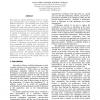Free Online Productivity Tools
i2Speak
i2Symbol
i2OCR
iTex2Img
iWeb2Print
iWeb2Shot
i2Type
iPdf2Split
iPdf2Merge
i2Bopomofo
i2Arabic
i2Style
i2Image
i2PDF
iLatex2Rtf
Sci2ools
111
click to vote
ICPP
2006
IEEE
2006
IEEE
A Performance Model of the Krak Hydrodynamics Application
We present an analytic performance model of a largescale hydrodynamics code developed at Los Alamos National Laboratory. This modeling work is part of an ongoing effort to develop models and modeling techniques for large-scale codes and systems of interest to Los Alamos and the national laboratory community [3]. Krak [1] comprises over 270,000 lines of source code and is capable of executing on a large number of parallel processors. Developing an accurate model is complicated by the irregular partitioning of input spatial grid cells to processors and the various material properties assigned to each cell. Model development proceeds by separating inter-processor communication from computation and modeling each individually. In addition, several approximations concerning subgrid size, shape, and material composition are made which reduce modeling complexity without adversely impacting prediction accuracy. We validate our model on several spatial grid sizes and processor configurations an...
Distributed And Parallel Computing | ICPP 2006 | Los Alamos | Los Alamos National Laboratory | Spatial Grid |
| Added | 11 Jun 2010 |
| Updated | 11 Jun 2010 |
| Type | Conference |
| Year | 2006 |
| Where | ICPP |
| Authors | Kevin J. Barker, Scott Pakin, Darren J. Kerbyson |
Comments (0)

